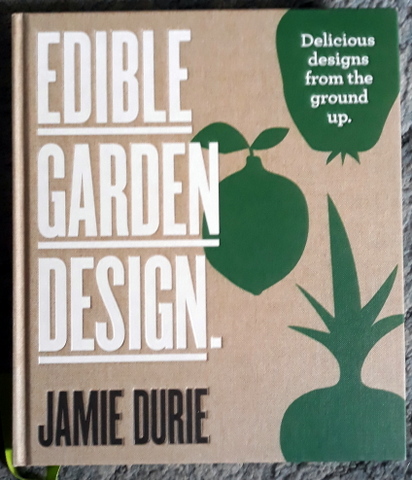De-lawning your front yard is the idea of replacing a lawn which only consumes with various plants and structures that are productive by providing food or other products, helping to improve biodiversity and contributing beauty to your suburban front yard. The following books provide information on two aspects of delawing, the first one being the process itself and the second covering information on the concept of edible landscaping. More details on de-lawning your front yard may be found here
The Process
The Edible Front Yard – Ivette Soler – Timber Press (US) 2011 ISBN 978 1 60469 199 3 – Even though this book reflects the US experience, if you can only afford on book for your de-lawning this should probably be it. The first chapter features some good introductory comments o front yard growing, Chapter 2 & 3 give a rundown on 72 productive and beautiful plants (fruit, veg, herbs & flowers) suitable for a front yard including how to grow and now to use each one. Chapter 4 gives and intro to garden design from an attractiveness perspective, and chapter 5 illustrates various whole-yard designs. Chapter 6 discusses assessing your front yard prior to starting, chapter 7 covers removing and reusing plants and materials during the front yard project. Chapter 8 looks at the infrastructure including irrigation, landscaping features and privacy; Chapter 9 covers maintaining the garden organically and chapter 10 covers harvesting and keeping the garden going. Lots of colour photos and side boxes with descriptions of specific projects.

Edible Estates: Attack on the Front Lawn – Fritz Haeg – Bellerophon Publications (US) 2008 ISBN 978 1 93305 74 0 – This is a project by Fritz Haeg with contributions from Diana Balmori, Rosalind Creasy, Fritz Haeg, Michael Pollan and Lesley stern. This is not a ‘how to’ book but more about why it is a good idea and what people have done. The first part of the book is about the Edible Estates project and why it is important, followed by an article by Michael Pollan on how he came to the conclusion that lawns were not a good idea, followed by an article on the democracy of the lawn in America and the last article is from Rosalind Creasy on how she set up he productive front yard garden. The second part of the book gives designs, pictures and descriptions for what they call Regional Prototype gardens from the US (3) and London (1). The third part provides descriptions and monochrome pictures of front yard gardens in various US climatic ones. There are also regional planting calendars for US climate zones 10 through to 3 and other resources. Lots of colour and monochrome pics and some diagrams.

How to Create an Eco Garden – John Walker – Anness Publishing Ltd (UK) 2012 ISBN 978 1 903141 89 2 – There is a lot of information in this book, each two page spread contains information on a single subject and lots of colour photos so there is not a huge amount of data on each subject. The book covers yards, courtyards and allotments but most of the info is front yard applicable. The first chapter is eco garden ‘greenprints’ and gives layouts for various size gardens, Chapter 2 talks about basics like tools, sowing seeds, feeding plants, companion planting and establishing an ecosystem. Chapter 3 covers soil care and composting, mulching and cultivation of the soil, Chapter 4 covers greenhouses, cover crops, water harvesting and storage and irrigation techniques. Chapter 5 covers some of the issues specific to food gardening, including planning, planting and fruit in containers, Chapter 6 covers the how and why of improving garden biodiversity, chapter 7 is about sustainable landscaping and chapter 8 is directory of eco-plants, reflecting the UK experience. Lots of colour photos.

Food Not Lawns – H.C. Flores – Chelsea Green (US) 2006 ISBN 978 1 933392 07 3 – This book is really about activism by using your grassed areas (including the front lawn) to grow food. Some of the techniques in the book are very innovative and urban/suburban friendly. The first chapter is about how the idea came about and the why’s and wherefores of converting your lawn to food. The second chapter talks about getting started by planning, making the most of your space and identifying resources and using them in the city and suburbs. Chapter three talks about the water cycle, its importance, making the most of water in the city by reducing your usage and harvesting it where you can. Chapter 4 talks about the soil, maintaining it, composting and improving your soil, chapter 5 talks about plants and guilds, plant functions, layering in time and space, edible weeds and chapter 6 covers seed stewardship. Chapter 7 discusses the process and tools for designing your de-lawned space including permaculture principles. Chapter 8 covers taking things beyond the garden including reducing energy use and buying less, chapter 9 talks about involving the community by getting involved in projects, teaching others and activism, chapter 10 talks about reaching out and connecting with likeminded people, chapter 11 covers working together and chapter 12 talks about working with kids. Lots of line drawings and diagrams.
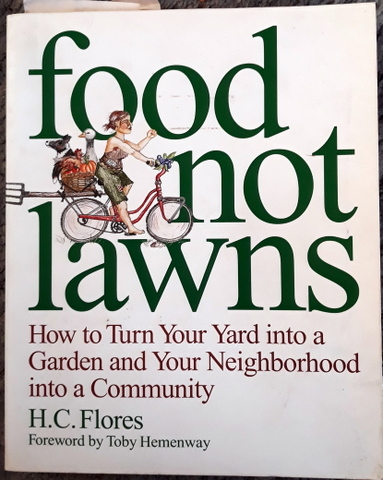
Gardening Your Front Yard – Tara Nolan – Quatro Publishing Group (US) 2020 ISBN 978 0 7603 6486 4 – While some of this book focusses on aesthetics, there is some good info and ideas on increasing front yard productivity and reducing lawns. Chapter 1 sets the scene and talks about front yard inspiration, processes for removing grass, addressing security concerns and dealing with a slope. Chapter 2 covers ideas for turning the front yards into a social space. Chapter 3 discusses ideas for improving the aesthetics as well as some productivity improvement like adding pollinators, chapter 4 goes into detail around front yard veggies. Chapter 5 covers water storage, diversion and use in the front yard as well as wildlife and pollinators. Chapter 6 covers improving front yard aesthetics again with various projects. It is a bit of a coffee table book without huge amounts of detail, but some good project plans and lots of colour photos.
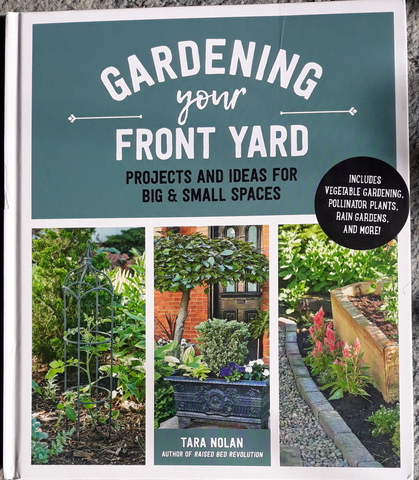
Edible Landscaping
The Complete Book of Edible Landscaping – Rosalind Creasy – Sierra Club Books (US) 1982 ISBN 978 0 87156 278 2 – I guess this is called the Complete book of edible landscaping, because it is! The book is written in three parts – Part one is entitled Foodscaping and how to do it, and it is basically the principles and practice of edible landscaping. It first talks about growing food without chemicals and why you might want to grow your own. It then moves into energy conservation, water conservation and soil conservation, landscaping history, groundwork such as planning, soil testing and elements of the landscape. Designing your landscape with edibles and small area landscaping and then covered, followed by planting and maintenance. Part two is an encyclopaedia of edible plants (92 of them!) listing for each one things like how to use them in the kitchen and landscape, how to grow them, how to buy them, preserve them and a recipe or two. Part three is a compendium of resources and references but I would suspect that, because the book is USA-centric and published 40 years ago, most of them would no longer be applicable. The book has lots of line drawings, colour drawings and colour photos. A must for the library.
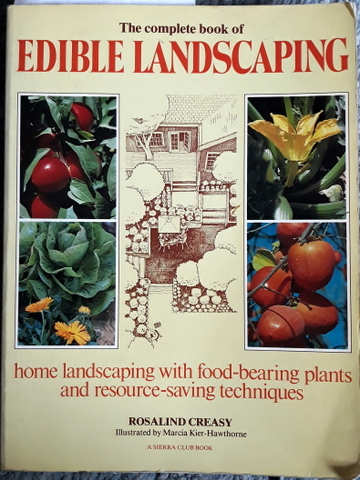
Designing and Maintaining Your Edible Landscape Naturally – Robert Kourick – Permanent Publications (UK) 2004 (originally published by Metamorphic Press, US, 1986) ISBN 978 1 85623 026 0 – Another oldie but a goodie! The book is written in eight parts. Part one provides an introduction, talks about organic gardening myths and facts and understanding your property: climate, soil and existing vegetation. Part two covers the design and talks about planning before you plant, an energy conserving landscape, then putting it all together. Part three covers growing vegetables and part four covers growing tree crops. Part five covers biological balance with insects including companion planting and integrated pest management. Part six covers soil and soil improvement, part seven covers mixing trees, lawns, flowers, herbs, vines and vegetables and part eight gives a review of 13 edible plants including their growth requirements and a recipe or two for each one. The book has a central section with lots of colour photos and plenty of line drawings and tables throughout the book.
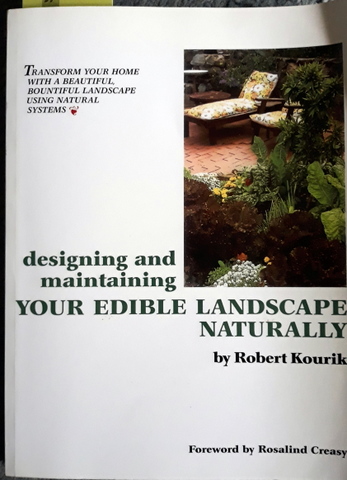
Edible Landscaping with a Permaculture Twist – Michael Judd – Self-published, distributed by Chelsea Green (US) 2013 ISBN 978 0 615 87379 4 – This one is nowhere as comprehensive as the two previous works, but rather takes various ideas and shows how they are constructed and can be integrated into an edible landscape. The first chapter talks about how to construct and then plant out a herb spiral including what parts of the herb spiral suit which herbs. Chapter two talks about rainwater harvesting, in particular using swales and raingardens, chapter three talks about growing specialty fungi outdoors, chapter four goes through food forests and guilds. Chapter five talks about growing uncommon fruits such as persimmons, paw paw and kiwifruit, gooseberries and currants, as well as shaping and pruning and grafting. Chapter six covers designing and building hugelkultur beds and chapter seven talks about designing and building your own earthen oven. The book has lots of colour photos and coloured illustrations.
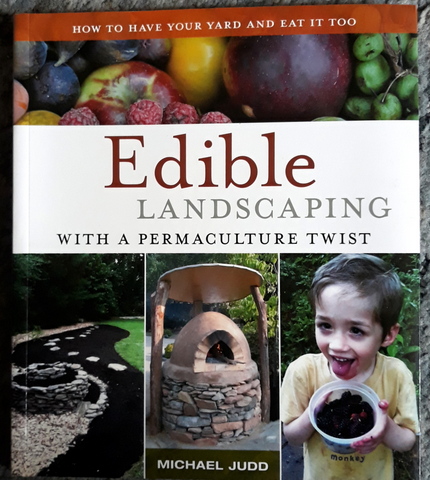
Landscaping with Fruit – Lee Reich – Storey Publishing (US) 2009 ISBN 978 1 60342 091 4 – The book commences with an introduction to the joy of home grown fruit with the second chapter covering landscape design basics such as plants as design elements, site analysis and putting it all together. Chapter three covers considerations in planting such as climate assessment, soil and sun and conducting a personal assessment to work out what you want. Chapter four covers growing the plants including selection, pollination, planting, pests, pruning and soil care. Chapter five provides five sample home landscape plans including a patio fruitscape, modular backyard and a children’s garden, each entry providing an introduction, list of edibles and ornamentals in place and sketches from various angles. Chapter six is a guide to fruiting landscape plants providing monographs on over forty fruits with each monograph providing statistics, general introduction, seasons of visual interest, plant size and growth habit, growing tips, varieties (in US), regions of best adaption (in US) harvest storage and use, plus a colour photo or two. The book has lots of colour photos and some colour sketches.

All-in-one Garden – Graham Rice – Cassell Illustrated (UK) 2006 ISBN 978 1 84403 451 8 – while this book does not sell itself as an edible landscaping book, it really is one, written around the premise that you can grow productive plants and attractive plants in the same bed (who knew?). After an introduction, chapter 0ne – food and flowers – talks about the benefits of fresh food, growing food in small spaces, planning and growing attractive as well as productive crops. Chapter two – sites and situations – talks about planting out small spaces, larger spaces, shady areas, sunny and dry areas, raised beds and containers with lots of plant lists to suit each area. Chapter 3 – Seasonal food and flowers – covers planting and growing the all-in-one garden through the seasons and chapter 4 provides a plant list covering fruit and berries, vegetables, family by family, starting out with cut-and-come-again veggies, fifteen herbs, and nine edible flowers. There is a paragraph or more on each plant. Chapter 5 – planting and maintenance – covers just that, talking about soil, compost and mulch, watering, seed sowing, planting, maintenance, succession planting and spraying (or not spraying!) most subjects being given a page or so. There are lots of colour photos and some line drawings in colour of some examples of set out in various all-in-one gardens.
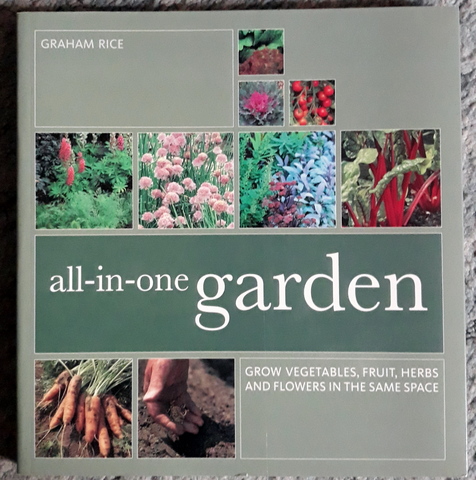
Edible Garden Design – Jamie Durie – Penguin Group (AUS) 2003 ISBN 978 1 921383 08 03 – This is an interesting book and quite good given two caveats – there are a lot of beautiful colour photos but not huge amounts of information for the size of the book, and about 50% of the designs he reviews are from overseas. The book has Seven chapters – Delicious Design; Edibles Anywhere; Vertical Gardens; The Kitchen Garden Reinvented; Community Connection; Permaculture and An Edible Future. Each chapter provides information about the subject (first chapter provides good information on the elements of design) and then reviews a garden or gardens to illustrate how they model the information in the chapter. Generally the review starts with a Q&A with the owner, a section on what he likes about the design and then a section on how the reader can replicate design elements. This book does have lots of good ideas, and a huge number of colour photos.
